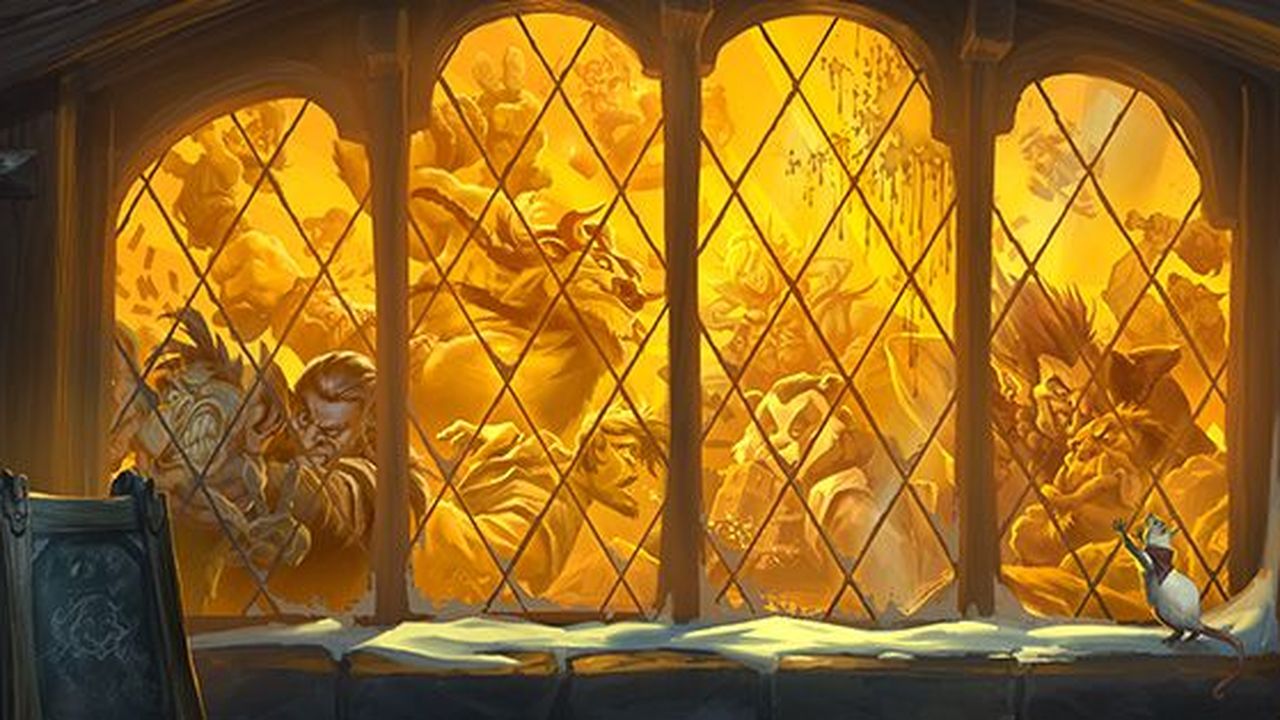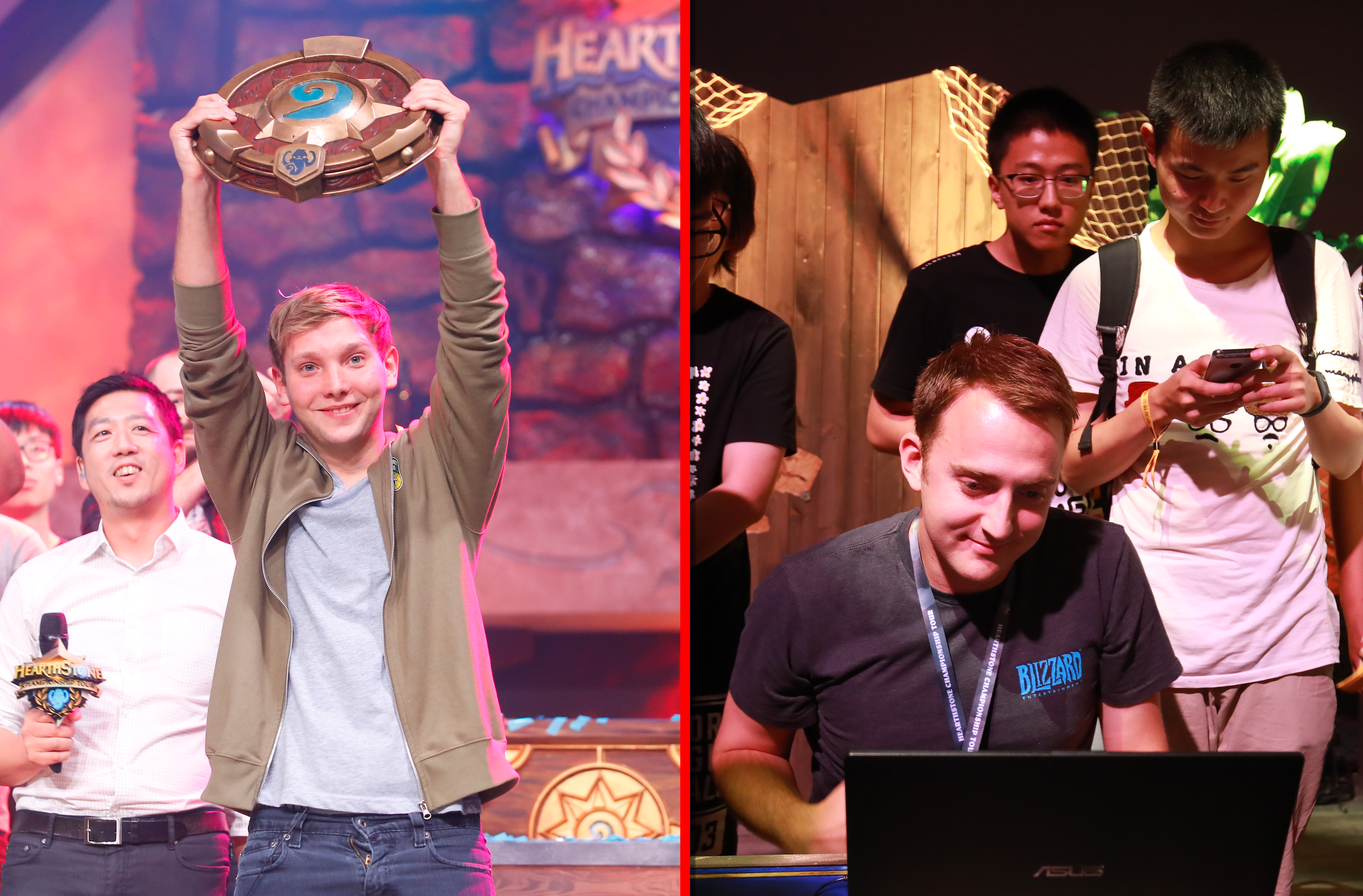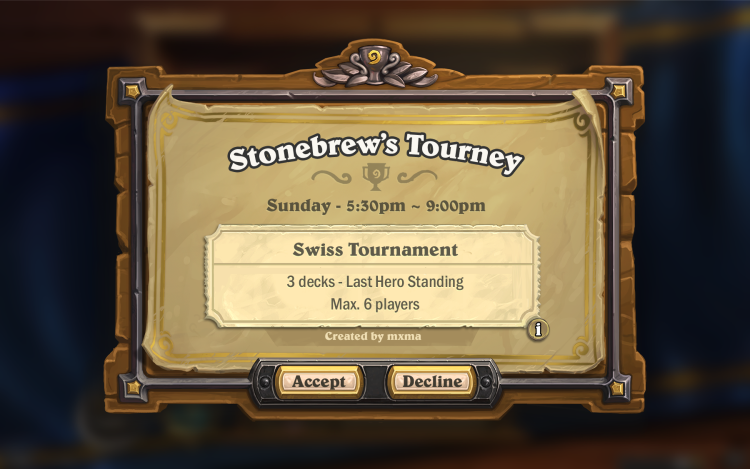Hearthstone announced a in-game tournaments in February. But on September 18, publisher Blizzard Entertainment revealed that this long-anticipated multiplayer feature was going on hiatus. This surprised the community, especially since the studio had been so quiet about the mode’s development.
The folks on Blizzard’s Hearthstone team are talking now. In an interview with GamesBeat, Hearthstone creative director Ben Thompson talked about the recent moves. I started asking Thompson about technical issues, but he says the team didn’t decide to shelf tournament mode because of any problems with Unity, the game engine that runs Hearthstone. Nor did it have to do with departures of senior team members, such as ex-creative director Ben Brode or former lead producer Yong Woo.
No, Blizzard put Hearthstone’s tournament mode on hiatus because of the gulf of expectations that existed between what the developers were working on and what players wanted. As Brode explained when “in-game tournaments” were announced in February, you’d be able to play a Standard or Wild event featuring Last Hero Standing or Conquest (two formats that Hearthstone’s esports follow), but you wouldn’t be able to offer bans, set up Arena-like or Sealed events, or set up more sandbox options.
Turns out, though, that a numbers of players wanted those options (and/or others). Thompson explained how Blizzard game to this decision. Here is our edited transcript of our discussion.
Technical issues?

Above: Hearthstone creative director Ben Thompson
GamesBeat: Let’s start with tournament mode. Just to confirm, tournament mode is not canceled — it’s just on the shelf, on hiatus?
Ben Thompson: Yes. Basically, what we’ve been saying is it’s on indefinite hold. We don’t have a set timeline that we’re looking to bring that back online. It’s not something we’re looking to get rid of entirely, honestly. We just don’t want the community to get the wrong idea. It’s on hold. We’re still talking about it.
GamesBeat: Was the Unity game engine holding it back?
Thompson: It’s actually nothing to do with Unity at all. Unity’s been a great partner throughout the development of the game, and they continue to be such. Anything and everything we end up doing with Unity has only made the game better. As far as tournament mode, it has nothing to do with them at all.
GamesBeat: Was the tournament mode you were working on causing too much software bloat?
Thompson: Each and every time we add a feature to Hearthstone, we do so with an eye toward what it does to the size of the client, the size of the download. We always have an eye toward mobile specifically being a big determining factor for anything when it comes to size or bloat. The tournament mode specifically didn’t come down to client size, or even how it performed on mobile or PC or desktop or any of it. It was not a performance issue at all.
GamesBeat: How did this tournament mode perform in testing before you shelved it?
Thompson: The very bare stuff we had in, the bare minimum as we were doing testing and proving out, performed fine, the aspects we had in. That was all working well.
GamesBeat: Would you say it was as performant as Arena mode or Tavern Brawl or Casual or Standard?
Thompson: No, I wouldn’t say there’s any difference between them.

Above: Tavern Brawls are the only mode Blizzard has added to Hearthstone since its 2014 launch.
GamesBeat: Was there a problem with making it a cross-platform app, between PC and mobile, for what you’re trying to do?
Thompson: It’s kind of a similar thing when we’re talking about the client size or performance or any of those. Certainly, whenever we suggest implementing any new mode to the game, it’s always going to be done with an eye toward cross-platform. Something that’s been part of Hearthstone since day one is performance and accessibility across platforms. This would be no different. There was no discernible difference to us as far as how it performed across platforms on any of them.
GamesBeat: If it’s not the software, did you just need a different set of people on the team? Were there not enough people on the engineering team to make this work? Did you need a different knowledge base?
Thompson: I’d say it had nothing to do with how the team is composed. Certainly we’re always keeping an eye on team composition for any number of reasons. I think a temptation — sometimes this temptation is internal as well, to the company and the team — is to believe that any time we’re approached with a cool or interesting idea, or one we know is going to be more challenging to another, that headcount will solve it. The reality is that often headcount doesn’t solve it. Sometimes it has the potential to make things worse. Any time we take on a new feature or consider even adding headcount for day to day, we do so with a very keen eye. We do so in such a way that we know it will only make the game and the team as a whole better with those introductions to the group. With regards to tournament mode, it’s not something that we believed additional people, additional headcount, would have changed.
The reason? Gulf of expectations
GamesBeat: Did the recent departures of senior leaders factor into tournament mode?
Ben Thompson: It would be understandable if people thought that. I can certainly see where that could be true in some people’s minds.
Speaking as someone who’s been on the team for nine years — the fifth employee on the team — this is something we’ve talked about in passing for a while. We’ve had interest in it as a team, off again and on again, as we were thinking about different things for the game. As we started to tackle it this year, when we talked about it at the beginning of the year, it’s something the team was behind uniformly. It wasn’t necessarily the brainchild of a single person, or even a single group of people, on the team. And myself included, we were very excited about what something like tournament mode could bring to Hearthstone.
I’ll be honest with you. When we looked at something like tournament mode, we did something with tournament mode for the very first time that we’d never done before in the history of Hearthstone. What that was was to announce a new mode to the game, a new feature to the game, so early that it started to take on a life of its own. As we continued to work on and produce aspects of what we hoped would ultimately become tournament mode, that lead time of the announcement allowed a simultaneous discussion to be taking place with the community. That allowed for a lot of time for the community to form, in its collective head, what they believed tournament mode could be, or should be. The more time that happened, what we did in that case was allow for two paths of thought to be created. You had the devs working on what they believed tournament mode should be comprised of, and the community building up in their own heads what they hoped and thought it would be.
Ultimately, as we approached the end of the year, the delta between those two was so great that we didn’t ultimately believe the resulting tournament mode we had been working on would meet the hopes and expectations of a player base that we only want to ever do right by. As we started to hear the feedback and thoughts from the community as to what they were thinking it would be and where we thought it could be, we thought that the best case scenario for this would be to take a long, hard look at where we’re at and to reassess that and revisit it at a time we would be able to create something much more close to the hopes and expectations of not just our players, but even ourselves as well.
GamesBeat: Let me get this straight then, make sure I have this right. One of the biggest reasons, if not the biggest reason, you put this on hold, is because of the gulf that was created between what you as the development team intended and what the community was wanting from it.
Thompson: Yes, in a nutshell.
GamesBeat: So this is an example of the dev team listening to the community and saying, “We hear you. We’ll give it another go.”
Thompson: Absolutely. I think that’s a good way to put it.
We are only ever interested in creating, as we’ve said time and again, a Blizzard level experience. That experience extends not to the game as a whole, but any one feature or mode in a game. We don’t feel that experience ends at the game level. It extends to every feature we put into the game. It extends even to the early access or beta for a thing. We feel like if the beta for that mode or feature isn’t going to amount to what we hope to deliver for a feature, then it’s something we feel we’re not going to get usable feedback from or even a good read on where we stand with it. As a result, we felt it was best to put this on hold even before the beta became a thing.
GamesBeat: What one thing created the biggest gulf between expectations and what you were working on?
Thompson: I wish it was just one thing. If it was just one thing, that would really be a much clearer answer for all of us, players and developers. It’s a bunch of small, tiny things, some bigger things, and ultimately wanting to stay true to the credo of the game’s conception, which is a game for anyone. Any time we add something to the game, something has to appeal to the largest number of players as possible and give everyone the broadest chance to enjoy everything we add.

Above: Hearthstone creative director Ben Thompson says esports didn’t play a role in the decision to put in-game tournaments on hiatus.
GamesBeat: Did esports play a role in this decision?
Thompson: No, there weren’t a lot of discussions between formal esports and the dev team when it came to this feature specifically. This mode was intended to empower players and be enjoyed at the player level. So no, that was not a deciding factor in the discussions.
GamesBeat: Did the fact that players were saying we want this tournament mode to be more robust and have more options than what you’ve announced a factor in your decision to put tournament mode on hiatus?
Thompson: That plays into what I was saying earlier, with the idea of players expressing their concerns, their wants, their desires for a mode like this. Those things and others were said, and I think that comprises, in many ways, the whole of the feedback we were starting to hear, that we took in part, or in whole, as it compared to what the tournament mode was at the time we were hearing a lot of this.
GamesBeat: When it comes to the feedback, was there once piece that stood out, one thing people were saying that you agreed with?
Thompson: Again, it’s the same answer, whether there was one thing we saw as standing out or that was missing and we could have added. It was the same type of thing with the feedback. The feedback was varied and came from a variety of different places, but because it was all coming from our players at every level — the hardcore players, the more casual players. We saw that as the player base of Hearthstone as a whole putting their voice behind something we wanted to do right the first time. So in other words, there was no one piece of feedback. There wasn’t even one specific group. It was a series of different questions or asks or curiosities from the community that addressed different aspects of a very large system, a very game-wide system.
GamesBeat: When it comes to tournament mode, how difficult is it to weigh the wants of that hardcore, plays-15-or–more-games-a-day base, the folks making videos and talking on Reddit, versus the larger casual base that might play once a day or less?
Thompson: That’s kind of the crux of the discussion when we talk about Hearthstone as a whole. It’s made up of both sides and everything in between in that player base. We want to make sure that each side of it is heard and addressed. We want both sides to feel taken care of, and both sides to feel as though they have something in a feature like tournament mode to turn to. We felt, in large part, we didn’t want to create a feature that only leaned one way or the other, because in that kind of scenario, it speaks to only one side of the equation. A game like Hearthstone is greater than the sum of its parts. It’s all those things put together that make it the game it is, a game for everyone. This feature is something we wanted to take seriously and figure out all parts of it for the community.
GamesBeat: If it comes down to the tournament needs of the hardcore audience being different than the tournament needs of the casual audience, would you entertain making two modes?
Thompson: I wish we had a clearer answer for something like that. That’s an example of a question we’re going to have to ask ourselves in the months, days, years to come, all the time we’re spending to determine what’s right for this feature. I can’t honestly say what the right answer to that it is. We’ll take that in kind with all the other questions we’ll ask ourselves going forward.
GamesBeat: Is it easy to think, oh, if we take care of the hardcore players, it doesn’t matter what happens to casual players, because they’re quiet anyway?
Thompson: It’s never been a temptation for me personally. The team as a whole has always seen that there’s a large player base for a game like Hearthstone and both sides are important. We’re always concerned with all parts of our player base. When you look at the hardcore, as you say, they can be the most vocal. They can be the people with more intricate, complex questions or thoughts about certain things. When you look at the new players, they’re equally important. New players or casual players are players spending just as much time and investing just as much of their hours or dust into building decks and playing the game. That’s not a temptation of my own — I can’t speak for the whole team — to cater to just one side or the other. Each brings with them a very important facet of the player base in a game like Hearthstone, and as such, we would want to always find the best solution that addresses everybody. I can’t say everybody equally, but everybody in such a way that they feel they were heard, they were listened to, and the answer we came up with was the best one for the game.
GamesBeat: In trying to please every audience, is that going to be in search of a perfection that doesn’t exist?
Thompson: That’s certainly — some people say that’s a definition of insanity, to continually try to pursue that. However, I would say that by pursuing both, we can’t get caught in the loop of perfection on any one side of that, or both sides of that. You have to make an honest effort, though. If you’re going to fall short, it’s when you stop making the effort to try to please both groups and focus on just one. Yes, we’ll have “solved” a problem in a feature or in the game, but it might be less than what we could have achieved had we honestly given the greatest effort.
Having shipped a game like Hearthstone five years ago, having worked on Hearthstone as many years as I have personally, honestly we can address and hit all groups as equally as possible, and to some amount of success, whenever we possibly can. It’s always going to be a goal. It’s not something that puts us in an iterative loop where we can’t release anything. We release three sets a year. We release a lot of PvE and PvP content with those sets now. We’ll continue to do so in such a way that each group has something more to dig into when new sets come along.

